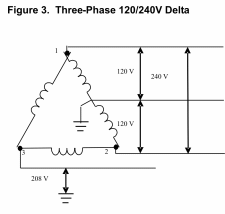Delta Configured Three-Phase Power from a Phase Converter
Nearly all phase converters produce three-phase power by generating a voltage that is added to the two legs of single-phase. The phase vector diagram in Figure 3 helps to illustrate how this is accomplished.

In the figure, 1 and 2 represent the two legs of single-phase service which are 180 degrees apart and have a potential of 240 volts between them. Ground and neutral
are halfway between these two voltages. The phase converter generates voltage 3 at right angles to the voltage between 1 and 2. If this voltage is generated at the proper level and at the correct angle, it will create a triangle when referenced to voltages 1 and 2 of the single-phase service. In essence, it is the same as the 120/240V delta power sometimes provided by the utility that was discussed earlier. The same warnings apply to deriving a phase-to-neutral voltage from the third phase. While the phase-to-neutral voltage from leg 1 or 2 is 120 volts, leg 3 to neutral (and ground which is at the same potential as neutral) will be approximately 208 volts. This is because in order to have balance phase-to-phase voltages, voltage 3 must be equal to one-half the voltage of leg 1 to leg 2 times the square root of three or, 240V / 2 = 120V x 1.73 = 208V.
If a piece of three-phase equipment operates only on phase-to-phase voltages, it does not matter whether the power is configured as wye or as delta. If none of the circuits in the machine or the motor being operated derive a voltage by referencing neutral/ground, the machine does not know or care where ground/neutral is in reference to any of the phases. It only “sees” the relationship between the phases. It is evident that if you reference the three voltages of wye power and “erase” the connection to ground/neutral, you have a triangle, the same as in delta configured power. Only when equipment has single-phase 120V circuits that are derived from phase-to-neutral connections does it matter if the power is configured as wye or delta.
If the three-phase equipment has 120V phase-to-neutral circuits that cannot be isolated and connected to either leg 1 or leg 2, the output of the phase converter must be passed through a 240V delta to 120/208V wye isolation transformer. This transformer will establish ground and neutral at equal distance from all three legs and deliver the power in a wye configuration.
This is especially important when operating some newer CNC machines that have certain Fanuc or Siemens controls. These controls handle regenerative power from the spindle motor by putting the regenerative power back onto the line utilizing a phase-to-neutral connection on all three legs. If these machines are powered by a phase converter with delta configured power, the regen circuit on the leg manufactured by the phase converter will operate at a voltage that is too high. An isolation transformer must be used to convert the power from delta to wye configuration.
No comments:
Post a Comment